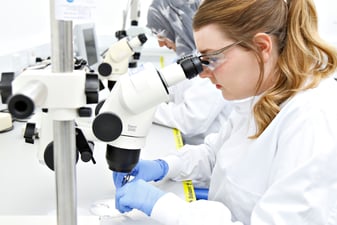Tissue biopsies have long been a cornerstone of clinical research, providing researchers with direct access to diseased and healthy tissue for analysis. In recent years, their role in clinical trials has expanded, offering invaluable insights into disease mechanisms, drug efficacy and personalised treatment strategies.
According to the National Health Service (NHS) website, ‘a biopsy is a medical procedure that involves taking a small sample of body tissue so it can be examined under a microscope.1 For example, biopsies can be taken from various tissues, including skin, breast, liver, and colon, to examine their cellular structure and detect signs of disease. Biopsies provide benefits across a wide range of clinical research, from dermatological to coronary studies, by providing data-rich, human-relevant insights. They play a crucial role in bridging the gap between preclinical studies and clinical trials, allowing scientists to validate findings from laboratory models in actual human tissue. Furthermore, biopsies enhance personalised medicine by tailoring treatments to patient-specific data, ensuring that therapies are not only effective but also aligned with an individual's unique biological makeup. Through these advancements, tissue biopsies continue to shape the future of drug discovery and patient care.2, 3
The potential of patient tissue biopsy donation extends beyond the scientific value – the act of donation itself also serves as a bridge between researchers and patients, fostering patient engagement in the drug discovery process. By measuring patient experiences, clinical trial researchers can gain a deeper understanding of both the physiological and psychological impact of procedures and treatments. These patient-centred tools not only enhance research quality but also empower individuals by ensuring their experiences and perspectives shape future therapeutic advancements.4
The Growing Importance of Patient Engagement in Clinical Research
Patient engagement is becoming an essential component of modern clinical research, ensuring that studies are aligned with the needs and experiences of those directly affected by the disease. As stated by the Canadian Strategy for Patient-Oriented Research, “patients bring the perspective as ‘experts’ from their unique experience and knowledge gained through living with a condition or illness.” This broad definition of the term ‘patient’ includes not only individuals with firsthand experience of a health condition but also their caregivers, advocates and representatives.5, 6
Patient-Reported Outcome Measures (PROMs) and Patient-Reported Experience Measures (PREMs) play a crucial role in evaluating healthcare quality and patient well-being. PREMs focus on patients’ experiences with care, assessing factors like communication, access, and coordination through tools such as CAHPS surveys. In contrast, PROMs measure patient health outcomes, including pain, mobility, and mental health, using validated tools like the SF-36 and PHQ-9.7 Together, these measures provide valuable insights that help healthcare organizations improve care delivery, enhance patient satisfaction, and tailor treatments to individual needs.
In the context of collecting tissue biopsies for research, patient engagement can transform the research process by fostering meaningful collaboration and interaction between patients and scientists. When patients are involved in research decision-making, their insights help shape study design, improving feasibility, acceptability, and relevance. This engagement also enhances mutual learning—patients gain a deeper understanding of scientific research, while researchers develop a more comprehensive view of what truly matters to patients. By integrating patient perspectives into biopsy-driven research, we can ensure that studies are not only scientifically rigorous but also patient-centered, ultimately leading to more effective treatments and improved healthcare outcomes.8
Building Trust Through Patient Engagement in Tissue Biopsy Based Research
Ensuring transparency and trust in clinical research is fundamental to fostering meaningful patient engagement. By involving patients throughout the entire research process – from study conception to the dissemination of results – researchers can create studies that are not only scientifically robust but also directly beneficial to those they aim to help. There is widespread agreement that patient engagement should be meaningful, impactful and measurable; however, the methods for achieving this remain inconsistent. Patients are no longer just passive participants in studies that affect their health, they are active contributors shaping research decisions.9
Incorporating patient engagement into tissue biopsy-driven research promotes a more democratic and patient-centred approach to healthcare. International funding agencies have recognised this shift, with organisations such as the Patient-Centred Outcomes Research Institute (PCORI) in the United States requiring patient involvement in study design, execution and outcome dissemination.10 Despite challenges in standardising engagement practices, the benefits outweigh the obstacles. The principles of reciprocal relationships, co-learning, partnership, trust, transparency and honesty are vital to effective collaboration between patients and researchers. Addressing barriers such as a lack of standardised training, clear guidelines, and documentation practices can help establish a global framework for patient engagement. By formalising these efforts, we can create a more inclusive, ethical and impactful research environment that prioritises both scientific integrity and patient well-being.11, 12
Tissue biopsy collection in pre-clinical studies and clinical trials offers patients a unique opportunity to contribute directly to the advancement of medicine. These tissue samples provide researchers with essential data to refine treatments, improve diagnostics and enhance our understanding of diseases.13 Beyond their scientific value, the biopsy donation process also serves as a gateway for deeper patient involvement in research. When patients are informed about the collection procedure and how their samples contribute to drug discovery and disease modelling, they become more engaged partners in the research process, fostering a sense of empowerment and ownership over their healthcare journey.14
Participating in research that requires a tissue biopsy collection can also enhance trust in the research process. By understanding the purpose and impact of their contribution, patients can develop a stronger connection with the scientific community and the healthcare system. Moreover, active participation in research helps bridge the gap between patient needs and medical innovation, ensuring that future treatments are not only effective but also aligned with real world concerns. Through greater transparency and patient involvement, research involving tissue biopsy collection and investigation has the potential to revolutionize clinical trials, making them more patient-centered, ethically sound, and scientifically meaningful.15
Challenges and Solutions
Despite the growing recognition of patient engagement in clinical research, several challenges hinder its full integration, particularly in biopsy-driven studies. One significant issue is the lack of standardized methods for engagement and the scarcity of data on its impact. Many studies fail to clearly define patient engagement or report how it affects project timelines, resource allocation, recruitment, and retention. Additionally, effective communication between researchers and patients is often a barrier—scientific jargon can lead to misunderstandings, frustration, and decreased participation. Another key challenge is ensuring that engagement efforts are meaningful rather than tokenistic; involving only a small, homogenous group of patients can limit diversity and weaken the research’s broader applicability. 16
Beyond engagement, the technical and logistical aspects of biopsies also present hurdles. The reliability of biopsy-derived data depends on several factors, including the sample’s location, size, and morphological integrity.17 Errors at any stage—sampling, processing, or interpretation—can lead to misdiagnoses, adverse patient outcomes, and increased healthcare costs. Furthermore, the risks associated with biopsy collection vary significantly depending on the procedure, with skin biopsies being minimally invasive compared to more complex organ biopsies, such as those of the liver or lung.18 Ethical concerns, particularly regarding informed consent and ensuring that patients fully understand the risks and benefits of participation, further complicate the process. Lastly, logistical barriers such as participant recruitment, retention, and ensuring diverse donor representation continue to challenge the field, potentially limiting the generalizability of biopsy research findings.19
To address these challenges, leveraging technology can play a crucial role in improving the donor experience and increasing participation in biopsy research.20 Digital platforms can facilitate clear, lay-friendly communication between researchers and patients, ensuring informed consent and enhancing transparency about the research process. Additionally, online portals can streamline recruitment efforts, making it easier to connect with diverse patient populations and monitor retention throughout the study.21
Transparent communication and community outreach are also key to fostering trust and inclusivity in biopsy-driven research. Engaging with patient advocacy groups, hosting informational sessions, and ensuring that patients have a voice in research design can make clinical research and trials more accessible and representative.22 Furthermore, ethical concerns surrounding biopsy collection can be addressed through innovative approaches such as 3D tissue models, which reduce reliance on patient-derived samples for certain preclinical studies. By integrating these strategies, researchers can not only enhance the quality and reliability of biopsy research but also create a more inclusive, patient-centred approach that benefits both science and society.
Enhancing Research and Patient Engagement
Tissue biopsies serve as a powerful tool in clinical research, offering invaluable, data-rich insights that drive drug discovery and precision medicine. Beyond their scientific significance, biopsies also present an opportunity to enhance patient engagement; empowering individuals to actively contribute to medical advancements. However, challenges such as logistical barriers, ethical concerns and the need for standardised engagement methods must be fully addressed to realise this potential. By leveraging technology, fostering transparent communication, and integrating innovative approaches like 3D tissue models, researchers can improve both the quality of biopsy-driven studies and the overall patient experience. As the field continues to evolve, a patient-centred approach to biopsy research will be essential in ensuring that clinical research and trials are not only scientifically rigorous but also inclusive, ethical and impactful for the future of healthcare.
References
- NHS Choices, NHS, www.nhs.uk/conditions/biopsy/. Accessed 11 Mar. 2025.
- Dermody, S. M., & Shuman, A. G. (2021). Implications of Research Biopsies in Clinical Trials. The oncologist, 26(12), 994–996. https://doi.org/10.1002/onco.13948
- Overman, M. J., Modak, J., Kopetz, S., Murthy, R., Yao, J. C., Hicks, M. E., Abbruzzese, J. L., & Tam, A. L. (2013). Use of research biopsies in clinical trials: are risks and benefits adequately discussed?. Journal of clinical oncology : official journal of the American Society of Clinical Oncology, 31(1), 17–22. https://doi.org/10.1200/JCO.2012.43.1718
- Ziv, E., Durack, J. C., & Solomon, S. B. (2016). The Importance of Biopsy in the Era of Molecular Medicine. Cancer journal (Sudbury, Mass.), 22(6), 418–422. https://doi.org/10.1097/PPO.0000000000000228
- Fergusson, D., Monfaredi, Z., Pussegoda, K., Garritty, C., Lyddiatt, A., Shea, B., Duffett, L., Ghannad, M., Montroy, J., Murad, M. H., Pratt, M., Rader, T., Shorr, R., & Yazdi, F. (2018). The prevalence of patient engagement in published trials: a systematic review. Research involvement and engagement, 4, 17. https://doi.org/10.1186/s40900-018-0099-x
- Defining Patient Engagement in Research: Results of a Systematic Review and Analysis: Report of the ISPOR Patient-Centered Special Interest Group. Harrington, Rachel L. et al. Value in Health, Volume 23, Issue 6, 677 - 688
- Churruca, K., Pomare, C., Ellis, L. A., Long, J. C., Henderson, S. B., Murphy, L. E. D., Leahy, C. J., & Braithwaite, J. (2021). Patient-reported outcome measures (PROMs): A review of generic and condition-specific measures and a discussion of trends and issues. Health expectations : an international journal of public participation in health care and health policy, 24(4), 1015–1024. https://doi.org/10.1111/hex.13254
- Porter L. D. (2022). The Importance of Patient Engagement to Improve Healthcare Research and Safety. Global journal on quality and safety in healthcare, 5(2), 27–30. https://doi.org/10.36401/JQSH-22-X1
- Porter L. D. (2022). The Importance of Patient Engagement to Improve Healthcare Research and Safety. Global journal on quality and safety in healthcare, 5(2), 27–30. https://doi.org/10.36401/JQSH-22-X1
- Forsythe et al. (2019). Patient Engagement In Research: Early Findings From The Patient-Centered Outcomes Research Institute. Health Affairs, 38, No. 3: 359-367. https://doi.org/10.1377/hlthaff.2018.05067
- Porter L. D. (2022). The Importance of Patient Engagement to Improve Healthcare Research and Safety. Global journal on quality and safety in healthcare, 5(2), 27–30. https://doi.org/10.36401/JQSH-22-X1
- Stewart, Moira, et al. Patient-Centered Medicine: Transforming the Clinical Method. CRC Press, 2024.
- BioIVT. Why Is Complete Data of Human Tissue Biospecimens Important?, 19 Sept. 2024, www.news-medical.net/whitepaper/20240919/Why-is-complete-data-of-human-tissue-biospecimens-important.aspx.
- Amino. “Step-by-Step Specimen Collection Procedure.” iProcess, 14 July 2023, iprocess.net/specimen-collection-procedure/.
- Redding, A., Copeland, L., Murphy, D. et al. Bridging the gap: empowering patients as research partners through a structured training program. Res Involv Engagem 11, 17 (2025). https://doi.org/10.1186/s40900-025-00685-4
- Porter L. D. (2022). The Importance of Patient Engagement to Improve Healthcare Research and Safety. Global journal on quality and safety in healthcare, 5(2), 27–30. https://doi.org/10.36401/JQSH-22-X1
- Jeffery et al (2003). Methods for the Assessment of Endobronchial Biopsies in Clinical Research. American Journal of Respiratory and Critical Care Medicine, Volume 168, 1-17. https://doi.org/10.1164/rccm.200202-150WS
- Dermody, S. M., & Shuman, A. G. (2021). Implications of Research Biopsies in Clinical Trials. The oncologist, 26(12), 994–996. https://doi.org/10.1002/onco.13948
- Tomasini, C. F., Michelerio, A., Isoletta, E., Barruscotti, S., Wade, B., & Muzzi, A. (2023). A Clinico-Pathological Multidisciplinary Team Increases the Efficacy of Skin Biopsy and Reduces Clinical Risk in Dermatology. Dermatopathology, 10(2), 153-167. https://doi.org/10.3390/dermatopathology10020023
- Wpab. “The Ultimate Cheat Sheet for Using Technology in Donor Management.” fundsforNGOs, 16 Feb. 2025, www2.fundsforngos.org/articles-searching-grants-and-donors/the-ultimate-cheat-sheet-for-using-technology-in-donor-management/.
- “The Benefits of an Efficient Online Recruitment System.” Recruiting CRM, www.recruitingcrm.com/blog/the-benefits-of-an-efficient-online-recruitment-system. Accessed 11 Mar. 2025.
- Three Ways to Engage with Patient Advocacy Groups to Build Trust in Clinical Trials : Parexel, www.parexel.com/insights/blog/three-ways-to-engage-with-patient-advocacy-groups-to-build-trust-in-clinical-trials. Accessed 11 Mar. 2025.





.jpg?width=1000&height=562&name=Untitled%20design%20(5).jpg)

